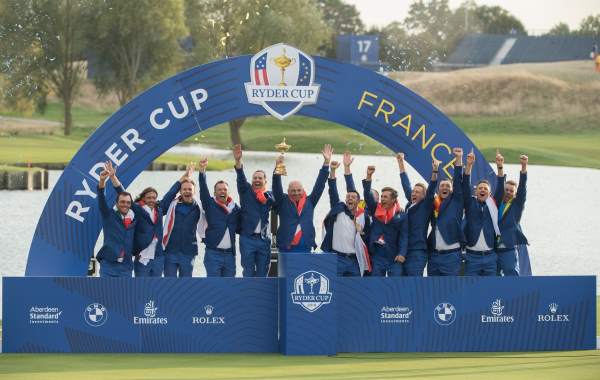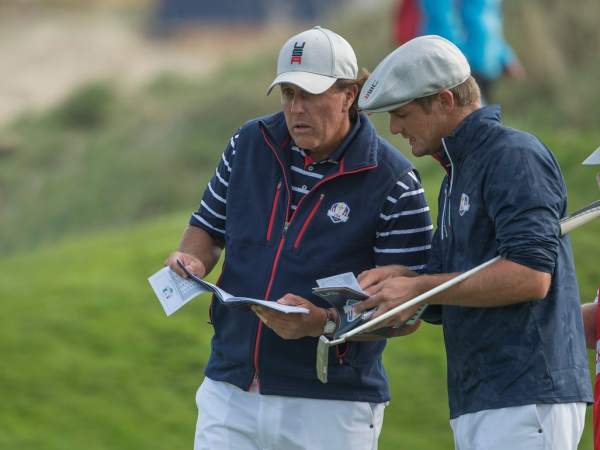After all the on-course dramas, the golf industry and the companies that work within it will soon declare their own winners and losers at the 42nd Ryder Cup writes Ross Biddiscombe. From the industry perspective, here is a personal view of who went home happy (whatever the result) and who left with a heavy heart.
Winners
Le Golf National

This might only be the second Ryder Cup on Continental Europe, but the course has been lauded by players and spectators all week. The viewing hills are unparalleled and helped create yet another unique Ryder Cup atmosphere. Le Golf National now transcends all the development issues of golf in France (whether they will ever work or not) – the course sits alone as a destination for golfers for the rest of its life. The Olympic Golf tournament to be played there in 2024 will only underline its status and another Ryder Cup on the Albatros Course is almost inevitable.
European Ryder Cup organisers
It is always a gamble to take an event like this into a new country with no strong culture for golf, but the commitment to moving the European Ryder Cup matches around the continent is the right thing to do for the industry in general. Long may it continue. Plus, the overall feeling about the general organisation was highly positive.
French Golf Federation
Federation boss Pascal Grizot got a special mention in Thomas Bjorn’s opening ceremony speech and it was deserved. Effective leadership of the bid and then the organisation to deliver on all the promises starts at the top and Monsieur Grizot also appointed the other two key men in this success story – general manager Paul Armitage and course superintendent Alejandro Reyes – so he got the basics right and good things happened from that moment on. True, one tournament like this will not totally change the French view of golf that it is too elitist and expensive, but this had to be a massive step in the right direction and, surely, inspire more players and fans. Even my own non-golfing Paris friends were excited about the match being in France.
Open de France
The next event at Le Golf National will be more eagerly-awaited than ever before so that all European golf fans can re-live the glory of the Ryder Cup. Having another huge tournament at the same venue should really help with the Federation’s development because the Ryder Cup memories provide a kind of continuity. Plus, only one American Ryder Cup player took the trouble to line-up in the Open de France in July – Justin Thomas – and, guess what, he scored four points out of five. If the Ryder Cup ever returns to this course, watch out for a ton of US players asking for invitations.
Sponsors
It might be obvious to say that any sponsors of an event that is as breathtakingly exciting and compelling as the Ryder Cup are automatically winners, but the point is that there were over 30 of them this year, at different partnership levels. The commercial supporters get very little branding on the course and nothing on the players, so they have to work a bit harder for their connection, but it’s definitely worth it.
Ryder Cup Logo
The Ryder Cup logo is not new to the 42nd match, but it is now becoming recognisable in the eyes of all sports fans, like the NFL shield or even the Nike swoosh. It’s neat and tidy, it works well on caps, clothing, mugs and even ball markers, plus fans are proud to wear it.
Richard Hills, Ryder Cup Director
For the last time in his 24 years at the European Tour, Richard Hills guided the European Ryder Cup behind the scenes and it was another triumph. No public fanfare, no media spotlight for him, just hard work and a clear understanding of the direction and strategy. A special presentation in the team room with the players and staff is said to have happened to mark his contribution. Well done, sir.
Losers
French professional golfers

This was their chance – Alexander Levy, Victor Dubuisson and all the other Frenchmen who were aspiring to elevate themselves into the top echelon. To qualify to play in a Ryder Cup in your home country is not easy for the Europeans and no French player could rise to the occasion. Of course, there will almost certainly be a great French player in the future who will make the team and even be a leader because there are plenty of them on Tour right now and, without Ryder Cup qualifying pressure, that man may soon emerge. But this opportunity may not come around again for the French players of today.
St Andrews and other iconic European courses
The Ryder Cup is different in the 21st century – the traditional iconic golf courses of Britain, the Open Championship venues, remain the sport’s historic homes, yet the various club secretaries and general managers must have looked at Le Golf National with envy. Masses of permanent infrastructure including fifteen kilometres of permanent cabling underground to provide connection for the wifi generation; space to build sky-high grandstands around the 1st tee and 18th green as well as in many other areas; stadium-style grass viewing banks almost everywhere; and a capacity for even more than 50,000 spectators per day. St Andrews and the courses built in the 19th century are getting left behind on some or all of these issues and it’s hard to see any of them as potential hosts of this event in the near future. This match may have moved beyond them.
SNCF
I said this was a personal view, so my experience of catching the of the French railway company’s 9.05 train from St Michel-Notre Dame on Sunday morning was not great. Of course, it’s easy to criticise and most of the anecdotal evidence from other days was much better, but one of the keys to the transport issue was to manage the peaks. My Sunday journey to one of the two main Ryder Cup destination stations, St Quentin en Yvelines, was long for me, but heart-breaking for fans who were left on platforms further down the line because the carriages were full.
The short SNCF train was opposite of what was needed – all week, long trains had been running in the mornings and fans having to wait another 30 or 40 minutes for the next scheduled train was inadequate. It rather kills your excitement for the event when you’re stuck in a train station.
Then the queues for the buses to Le Golf National were enormous. I had the comfort of the media bus, but I did the public bus journey myself earlier in the week and the length of the queues looked like it would take it maybe 40 minutes just to board a bus. Why only one boarding area? Then the 30-minute bus ride and the 20-minute walk from the course bus park (blimey it was a long way – I know because I did it on the Tuesday) makes for a torrid journey.
Add it up and, from central Paris, that’s two hours and 20 minutes without any other delays and it all starts with too few trains. Sunday was almost certainly the worst transport day, but it’s a shame if it spoiled a few Le Golf National experiences. Transport to every major sporting event is the most difficult job to get right and is always a nightmare for the unlucky ones, but mistakes like these could have been so easily solved ahead of time.
If you want to list your own winners and losers or comment on Ross Biddiscombe’s choices, email publisher@golfbusinessnews.com
Pictured top Fans silhouetted against an early morning sky at Le Golf National (photo credit Rolex)
Ross Biddiscombe’s acclaimed book Ryder Cup Revealed is available at amazon.co.uk via this hotlink: https://tinyurl.com/y9w75whd

